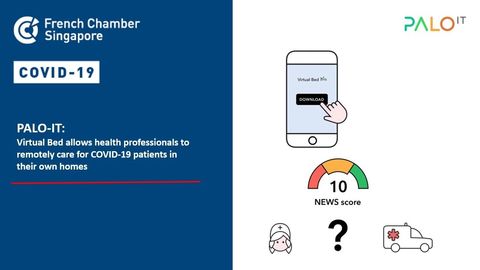COVID-19 • Members
PALO IT: Virtual Bed Allows Health Professionals To Remotely Care For COVID-19 Patients In Their Own Homes

This idea is inspired by a remote monitoring platform for hypertension and the need to prevent hospitals becoming overwhelmed by non-critical cases.
Palo IT is creating Virtual Bed, a cloud enabled mobile app that helps a small number of healthcare professionals provide care and support for vast numbers of patients. Virtual Bed will allow patients’ symptoms to be remotely monitored by healthcare professionals so that patients can stay in their own homes while also getting care from a healthcare professional should they need it.
Patients with confirmed or suspected mild to moderate COVID-19 symptoms can get care from a health professional without leaving their homes and risking spreading the virus or unnecessarily taking up a hospital bed.
Patients log onto a mobile app, and at regular intervals, record their symptoms, comorbidities (existing health conditions), risk factors, and health metrics such as temperature, respiratory rate, heart rate, sp02, and systolic blood pressure.
Virtual Bed creates a NEWS score (see https://www.mdcalc.com/national-early-warning-score-news for more info) from entered metrics and comorbidities, to determine whether the patient needs a face to face consultation or to go to the hospital.
Health care professionals can see patient entries via a dashboard and self-assign themselves to a patient to monitor and provide care to that patient remotely.
The health care professional can contact the patient and continuously monitor them to determine if they need to see a GP or go to the hospital.
The dashboard will display patients according to NEWS scores. Patients with a high NEWS score indicates they may need care more urgently than another patient and will go towards the top of the dashboard.
Metrics such as heart rate and blood pressure can be easily monitored using common smart devices but the system may be further improved with the home delivery of basic monitoring equipment like oximeters.
Benefits include:
Keeping patients with mild to moderate symptoms at home.
Providing the help, support and peace of mind a patient needs while they have the disease and recover.
Identifying patients with deteriorating conditions for referral or intervention.
Generating a massive data set for further study.
Next steps:
Taking this solution to health authorities, governments and hospitals for a trial and potentially a national roll out. Making the concept of virtual hospitals a much needed reality to help with potential influx of patients and save more lives.
For more information, visit https://devpost.com/software/virtual-bed


